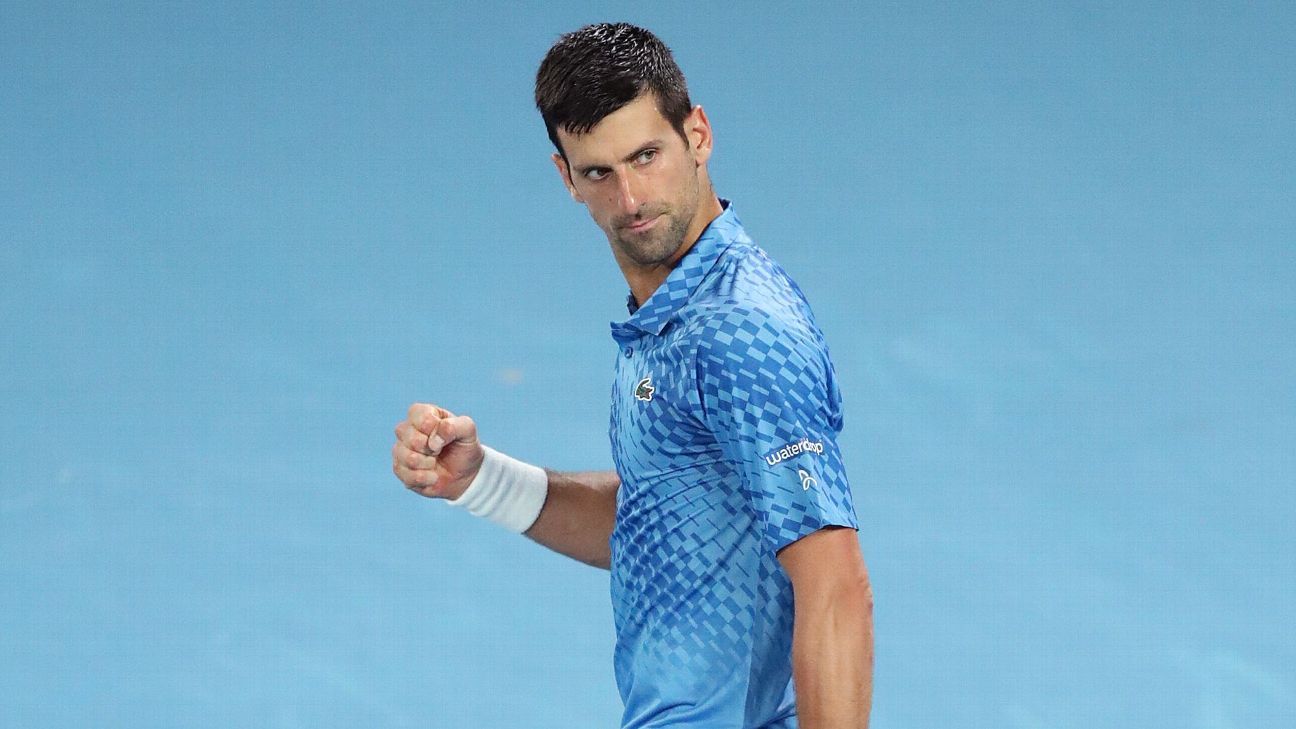Products You May Like
MELBOURNE, Australia — Novak Djokovic found this trip to Australia far less complicated, and far more successful, than that of a year ago.
Unable to enter his best event in 2022 after being deported from the country because he was not vaccinated against COVID-19, Djokovic accomplished all he could have wanted in his return: He resumed his winning ways at Melbourne Park and made it back to the top of tennis.
Only briefly challenged in the final on Sunday night, Djokovic was simply better at the most crucial moments and beat Stefanos Tsitsipas 6-3, 7-6 (4), 7-6 (5) for a record-extending 10th Australian Open championship and record-tying 22nd Grand Slam title overall. As a bonus, Djokovic will vault from No. 5 to No. 1 in the ATP rankings, a spot he already has held for more weeks than any other man.
“He’s the greatest that has ever held a tennis racket,” Tsitsipas said.
Djokovic stretched his unbeaten streak in Melbourne to 28 matches, the longest run at the tournament for a man in the Open era, which dates to 1968. He adds trophy No. 10 there to the seven from Wimbledon, three from the U.S. Open — where he also was absent last year because of no coronavirus shots — and two at the French Open, to match rival Rafael Nadal for the most by a man in tennis history.
Margaret Court, with 24, Serena Williams, with 23, and Steffi Graf, with 22, have the most among women.
This was also the 93rd ATP tour-level title for Djokovic, allowing the 35-year-old from Serbia to break a tie with Nadal for the fourth-most. Jimmy Connors holds that mark, at 109.
Djokovic was participating in his 33rd major final, Tsitsipas in his second — and the 24-year-old from Greece’s other one also ended in a loss to Djokovic, at the 2021 French Open.
He was superior throughout against Tsitsipas, but especially so in the two tiebreakers. He took a 4-1 lead in the first and after it was 4-all, pulled off three points in a row. He led 5-0 in the closing tiebreaker and, when it finished, he pointed to his temple then climbed into the stands, pumped his fist and jumped with his coach, Goran Ivanisevic, and other members of the entourage, and collapsed, crying.
Little doubt this is of no solace to Tsitsipas, but there is no shame in failing to defeat Djokovic in Melbourne. Challenging his dominion on those blue hard courts is every bit the monumental task that taking on Nadal on the red clay at Roland Garros is.
Perhaps surprisingly, Tsitsipas was willing to engage in the kind of leg-wearying, lung-searing back-and-forths upon which Djokovic has built his superlative career. How did that work out? Of points lasting at least five strokes, Djokovic won 43, Tsitsipas 30,
Then again, on those rare occasions that Tsitsipas did charge the net, he likely regretted the choice, because Djokovic often conjured up a passing shot that was too tough to handle.
One of Djokovic’s many other strengths is his return game, and he accumulated three break points within 17 minutes, converting the last for a quick 3-1 lead when Tsitsipas double-faulted.
The trophy for which they were playing was displayed on a pedestal near a corner of the court, and both men would get within reach of it whenever wandering over to towel off between points at that end.
So close, yes, but for Tsitsipas, never truly close enough.
It’s not as though Tsitsipas played all that poorly, other than a rash of early miscues that seemed to be more a product of tension than anything.
It’s that Djokovic was, put simply, too good. Too accurate with his strokes — making merely 22 unforced errors, 20 fewer than his foe — and anticipation. Too speedy and flexible chasing shots (other than on one second-set point, when, running to his left, Djokovic took a tumble). Too dangerous with his returns and damaging enough with his serves.
Djokovic pushes and pushes and pushes some more, until it’s the opponent who is something less than perfect on one shot, either missing or providing an opening to pounce.
There has been more than forehands and backhands on Djokovic’s mind over the past two weeks.
There was the not-so-small matter of last year’s legal saga — he has alternately acknowledged the whole thing served as a form of motivation but also said the other day, “I’m over it” — and curiosity about the sort of reception he would get.
He heard a ton of loud support, but also dealt with some persistent heckling while competing, including applause after the faults Sunday.
There was the sore left hamstring that has been heavily bandaged for every match — until the final, that is, when only a single piece of beige athletic tape was visible — and had worried him at the beginning of Week 1, prompting him to turn to what he said was “a lot” of pain-killing pills and other treatments he didn’t detail.
And then there was the more complicated matter of his father, Srdjan, being filmed with a group of people with Russian flags — one with an image of Vladimir Putin — after Djokovic’s quarterfinal victory. The tournament banned spectators from bringing in flags of Russia or Belarus, saying they would cause disruption because of the ongoing invasion of Ukraine. Both Djokovic and his father said it was a misunderstanding, based on Srdjan thinking he was with a group of Serbian fans.
Because of that episode, Srdjan Djokovic did not attend his son’s semifinal victory over Tommy Paul on Friday, and was not seen in the Djokovic guest box on Sunday.
No matter any of it, Djokovic managed to excel as he so often does, winning 17 sets in a row after ceding one in the second round last week.
